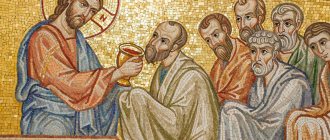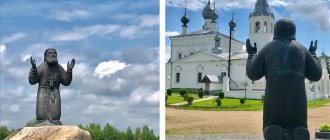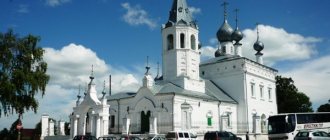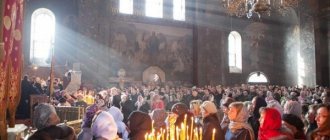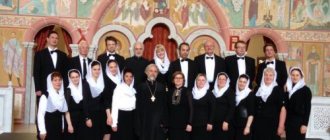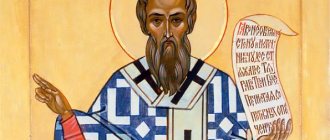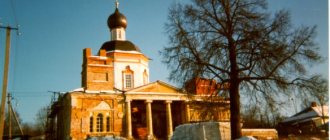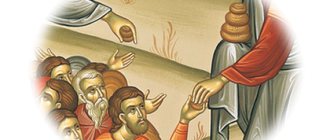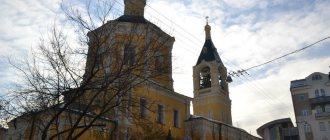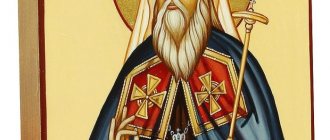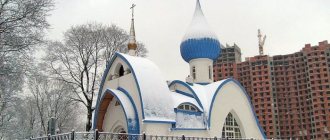The Church of St. John Chrysostom is one of the main cathedrals of the city of Yalta. The building was erected on a hill near the sea on Polikurovsky Hill. The beauty of this place delights local residents and tourists; many pilgrims come to the church, as it is a spiritual site of the Crimean coast with a rich history.
Church of St. John Chrysostom on Polikurovsky Hill in Yalta
History of the Church of St. John Chrysostom in Yalta
This resort town was not always a “Crimean pearl”. Back at the beginning of the 19th century, Yalta was a small fishing village, where there were 13 modest houses on several streets.
But the situation changed radically when Vorontsov was appointed governor of the Novorossiysk Territory. A new chronicle of the city began in 1823: guests and high-ranking officials began to come to Yalta, which contributed to an increase in the population, the opening of new shops, a customs post, post office, and banks.
The strengthening of the city led to the growth of the Orthodox parish. Therefore, in 1832, Mikhail Vorontsov decided to build the Church of St. John Chrysostom in Yalta. The cathedral complex was erected in 1835, and on September 16, 1837, the building was consecrated.
The 80s of the 19th century were the time of reconstruction of the cathedral. Nikolai Krasnov, an outstanding city architect, was called to carry out work on the redevelopment of the prayer house.
He completely changed the design of the church - he expanded the premises, left one dome, which also changed the style of the building itself to Byzantine.
During the reign of the Soviets, the history of the Church of St. John Chrysostom was also darkened by persecution. In 1937, the church was officially closed, and the building of the cathedral complex was transferred to a food warehouse. During the Second World War, the belongings of German colonists who were evicted from their homes by the occupiers were brought to the temple.
1942 is the most tragic page in the annals of the house of worship. Unknown persons set fire to the church warehouse, which led to the complete destruction of the building. The ruins stood in the city until the 1950s, after which the site was cleared and given over to a clothing market.
The only thing that has survived from the Church of St. John Chrysostom is the high bell tower, which was not demolished due to its navigational significance. This structure has been marked on all existing nautical charts.
Only with the collapse of the Soviet Union did it become possible to restore the monastery. In 1994, Vladislav Schmidt, who is the current rector of the cathedral complex, initiated restoration.
The project for the future building was developed by Petrova, a Crimean architect, who found the original drawings of Toricelli (the creator of the cathedral) in the archives.
For the next three years, work was carried out to restore the Church of Chrysostom in Yalta. In the fall of 1998, the church was consecrated, and in 1999, Orthodox crosses were raised above the cathedral.
The history of the cathedral
The southern towns of the Russian Empire, after the influx of Christian population, acquired churches, and over time, rich cathedrals. Yalta was no exception. The Church of St. John Chrysostom proves that the first attractions here are not hotels and equipped beaches, but buildings with domes and bells. In churches, Orthodox people could communicate with God and the clergy.
1835 turned Yalta from a village of 13 houses, where the first settlers after the Turks lived, into a large village. It numbered several thousand inhabitants. The town had a pier, a market, a postal station, shops, a police station and a customs office. Only the church was missing. This deficiency was corrected in 1835 by the Novorossiysk governor M. Vorontsov with an iron will. The official found money in the state treasury to build a “house of God.”
The place for the construction was chosen well - the terrace of Polikurovsky Hill closest to the embankment, it was visible from all the central streets. The first architect was the Englishman Elson, but the work was completed by an Odessa resident of Italian origin, Torricelli, who “sculpted” the pseudo-Gothic temple, using limestone blocks for its construction. Workers cut them out of huge pieces of rock and then painted them yellow. The unusual building has long served as the main landmark of the historical center.
In the 80s the century before last, the Church of St. John Chrysostom was significantly rebuilt. After reconstruction, its building was expanded. The number of domes was reduced to one. Now it looked like a Byzantine basilica. In Soviet times, no stone was left unturned from this landmark of Yalta. The Bolsheviks banned divine liturgies everywhere. The temple complex received its previous appearance only in 1994 - one of the historians obtained Torricelli’s drawings from the archives.
Schedule of services in the Church of St. John Chrysostom
The current schedule of services and liturgies is published on the official website of the cathedral complex. It contains current data for each month of the year, indicating the days when liturgies are not supposed to be held.
Therefore, it is better to track the schedule on the portal or find out by phone at the help desk.
There is a Sunday school on the territory of the temple, where both children and adults can come. Classes are held on Sundays, and for preschoolers lessons are also organized on weekdays from 9:00 a.m. to 5:00 p.m.
As part of the Sunday school classes at the Church of St. John Chrysostom, not only a theological course is conducted, but also foreign languages are studied.
Parishioners can enroll in a handicrafts club and learn to play the piano. Particularly noteworthy are classes in spiritual and choir singing, a theater group, a fine arts studio and an early development class.
Legends about the temple
Yalta keeps many myths. The Church of St. John Chrysostom, judging by the legend, was named so for a reason. "Polykur" is translated from Greek as "Staroselie". This is exactly the name given to the Yalta hill, towering above the sea, where fishermen have long lived. And their patron was John. They named one local cape after him, and the Russians, who came here later, found out about it.
They also found the ruins of an Orthodox church, built by the Greeks and then destroyed during countless wars. When exploring those ruins, they also discovered fragments of a marble icon - the head of Jesus. The Tatar toponym was ignored - the Russian settlers also consecrated their first church, built in a completely different place, in honor of the Chief Apostle John.
Parish of Chrysostom Church
St. John Chrysostom parish is a whole complex of buildings, which consists of a chapel, the temple itself and a Sunday school. On the school grounds there is a small shelter for pilgrims and a cafe-refectory.
On the territory belonging to the parish, there are church shops where guests of Yalta can purchase church utensils, souvenirs and Orthodox scarves. Also adjacent to the temple territory is an ancient cemetery, which thousands of tourists want to see.
It is also curious that in the territory of the parish of the Church of St. John Chrysostom in Yalta, Tatiana’s Day is revered on a special scale. In January, balls are held on the territory of the cathedral complex, and numerous thematic meetings of parishioners are also organized.
Sunday school at the temple
History of discovery
Today there is a Sunday school at the cathedral. It was built in 1898 according to the design of the architect N.P. Krasnova. The parochial school at the cathedral was named after Grand Duchess Olga Romanova, the eldest daughter of Tsar Nicholas II.
During the Great Patriotic War, the school building was destroyed. After the war, the building was dismantled for building materials by local residents.
Thanks to the efforts of the church parish, the school was restored in 2006 according to the previous design.
The interior design of the school delights with the beauty and richness of its architecture and modern interior design.
How does it work?
Children from five to sixteen years old are invited to study at the school. The following subjects are taught:
- foundations of Orthodoxy;
- singing;
- needlework.
The cathedral Sunday school also offers courses in many other areas:
- theological courses;
- preparing children for school;
- handicraft courses;
- sewing and clothing design courses;
- painting studio;
- choreography;
- ballroom dance club;
- performing arts studio.
In addition to classrooms, where children study in various clubs, the school also has a cafe-refectory, which serves delicious dishes. For believers who observe fasting days, delicious Lenten dishes are always available in the school refectory.
Since pilgrimage is the main part of the spiritual life of the Russian Orthodox Church, the church’s Sunday school operates a year-round “Shelter for Pilgrims.” This shelter is created for each person individually, and also operates for groups.
On the third floor of the school there are three comfortable rooms with shower and toilet, air conditioning and a refrigerator. Each room accommodates 4 people. Internet is available in the rooms.
During the summer season, additional rooms are equipped on the second floor of the school to receive guests who wish to combine a pilgrimage to the Orthodox shrines of the South Coast with relaxation. These rooms can accommodate 6 people.
In summer, groups of up to 25 people are accepted. During the rest of the year, up to 14 people are accepted. The shelter operates not only for adult pilgrimage groups, but also for children.
Sunday school teachers make great efforts to ensure that the life of the educational institution and parish is as rich and interesting as possible.
The main goals and objectives of children's Sunday school:
- raising children based on Christian principles;
- teaching the basics of the Christian faith;
- instilling church life skills;
- teaching children mutual assistance and understanding;
- development of creative abilities.
How to get there?
The Church of St. John is located at the address: Yalta, Tolstoy Street, 10. You can get to the holy monastery in various ways, the simplest and most popular are:
- Travel by city bus. You should take route No. 6, 18A, 21, 22 or 47. Buses go to Yubileiny Square, where the Clothing Market stop is located.
- Walking tour. As part of an excursion tour of Yalta, many tourists decide to walk to the Church of St. John Chrysostom on their own. The starting point of the route is the Lenin monument, standing on the main promenade of the city - the embankment. From the monument you need to turn onto Roosevelt Street and walk along it towards the marine terminal. Having reached the “sea harbour”, you should walk past the chapel of St. Nicholas, then go up to Tolstoy Street and turn right. Near the restaurant “Yard at the Pier” the temple ensemble is located.
Contact information and opening hours
Address of the religious organization: 298600, Russia, Republic of Crimea, Yalta, st. Tolstoy, 10.
Entry to the temple grounds is free.
Opening hours: from 10:00 to 17:00. The cathedral may be closed for cleaning from 13:00 to 14:00.
The Holy Monastery of John Chrysostom is a unique structure that amazes with its beauty, aesthetic forms, and splendor of the interior. It is cozy and warm here at any time of the year.
Where to stay in Yalta?
If you want to relax next to a pine forest, enjoy the healing juniper air, and dissolve in a comfortable and tranquil environment even in high season, book one of the 10 luxurious rooms at the Pallasa Boutique Hotel.
A Russian bathhouse made of Karelian logs, a fireplace, rare antiques, a fitness room, a plunge pool and an outdoor jacuzzi, a restaurant with original cuisine - we are sure that you will be able to relax here, both soul and body.
To contact the hotel administration, just dial +7-978-97-05-500 - the manager will tell you in more detail about the booking conditions and current prices.
